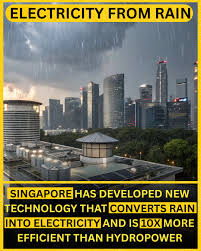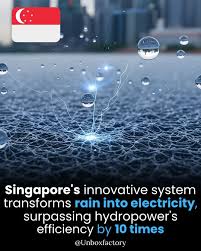Table of Contents
Introduction to the water scarcity issue in Singapore
As a busy Island city-state, Singapore has a constantly looming problem: inadequate water resources. The pressure on fresh water is on the increase with the world population becoming increasingly heavy and with less and less natural resources to meet the population size. But what is that the solution is as plentiful as rain? Creative thinkers in Singapore have shifted their focus to finding a new way of tapping into this golden resource and that is to make rainfall electricity. This revolutionary technology is able not only to solve the urgent energy crisis but also bring hope of a sustainable future in times of climatic crises. So let us see how Singapore is setting the pace in the conversion of raindrops into power.
How rain is being converted into electricity using innovative technology
Singapore has adopted the use of new technology to utilize the power of rain. The procedure starts with special materials which have the capacity to absorb kinetic energy released by falling rain. These materials transform mechanical energy to electrical energy and this makes them a sustainable energy source.
Another distinguished technique is using piezoelectric generators. The impact of rain drops on these gadgets changes their pressure to introduce an electric charge. This is quite efficient and assists in the process of producing electricity even during light rain.
The other method utilizes the use of water turbines installed in the draining systems. With the flow of the rain water passing through the turbines, the rain water rotates and as it rotates it produces electricity.
These strategies present an example of how Singapore uses its tropical weather to achieve more water management and energy demands at the same time.
Benefits of this technology for Singapore

The new technology of capturing rainfall to produce electricity has a lot of advantages to Singapore. To start with, it offers a source of energy that is sustainable and capable of lessening the dependency of the country on fossil fuel. The move is important towards boosting energy security.
As well, this solution uses water scarcity-, which continues to trouble the city-state. Through the utilisation of rainfall, Singapore will have an opportunity to transform an environmental adversity into a resource-efficient venture.
Besides, the introduction of such technology leads to growth in the economy through creation of employment in areas of research, development and maintenance. It also results in collaboration among the various industries dealing with sustainability.
Through this initiative, Singapore has been able to place itself at a high rank in terms of environmentally friendly innovations in the world. In promoting the use of clean technologies, it improves the popularity of the country in the global arena as other countries seek to copy its success.
Challenges faced during implementation
The city of Singapore has not been left behind in adopting the technology to turn rain into electricity without hitches. The biggest problem is the upfront expense of installing such innovative systems. Although they are long-term beneficial, to the stakeholders, the short time investment looks scary.
The other issue is centered on the infrastructure. It is very important that old buildings and public places are adapted to use these energy conversion technologies and proper planning and engineering skills are needed.
Social approval is of great essence too. The residents need to be educated in order to buy and to take the necessary action and get involved in this new method of approach.
Irreliability of weather is a big challenge. Basing energy production on reliable weather forecasts is a rather important task that can significantly boost energy output levels, but it is a job that proves to be quite difficult to complete in the constantly evolving climate environment.
Impact on the environment and sustainability
The new technology that can convert rain into electricity in Singapore is not only an engineering wonder but it is also environmentally friendly. Exploitation of this natural resource helps the city-state decrease its dependency on fossil fuels. This transformation reduces carbon emission massively.
In addition, the rainwater harvesting helps in improved management of water. Flooding because of excess rainfall is dangerous to the urban infrastructure and ecosystems. Some of these problems are alleviated by converting some of that rain to energy.
Such a solution fits the wider sustainability efforts because the use of renewable energy sources and reduction of wastefulness related to the conventional approaches toward power production is encouraged.
It remains one of the projects that can be emulated by cities around the world as they consider optimal means of courtesy to the environment. It demonstrates how innovation can be used to prompt environmental stewardship and help solve the key resource challenges that include water shortage and energy demand.
Other countries adopting similar methods
The world has learnt of an innovative method of using rainfall as a source of electricity applied by the Singapore state. Similar technologies which would turn rainfall into renewable energy are being explored in India as well. They concentrate on the incorporation of these systems and urban infrastructure.
Brazil is also moving towards trial of rain harvesting systems that work to generate electricity. They want to maximize energy production during wet seasons by use of specialized turbines.
Even countries in Europe such as Norway and Germany are also investing in high-tech solutions on water-to-energy. They consider two-fold advantages of surplus rainwater management along with power generation.
Such global initiatives show that there is an increasing tendency towards green energy production. With increasing weather patterns due to climate changes, this kind of technology might be another way to go especially to regions that have problems with water supply and who want to go greener.
Future possibilities and advancements in this technology
The world of rain-powered electricity has a lot ahead of it. With improvement in technology we might experience improved efficiency in energy conversion processes. This may result in even higher rainfall yields.
There are nanotechnology and smart materials innovations on the horizon. Such developments have potential to create smaller systems that produce energy without bulky infrastructure.
In-integration with urban planning is another potential field. Consider the presence of buildings, constructed having the facilities to harvest the rain as part of the building.
The research is ongoing to integrate hybrid systems by combining solar energy and rain energy gathering, where the most resources are utilised based on different weather conditions.
Scientists, engineers and policymakers will be important towards propelling this technology. The scalability potential also presents an insight on how city landscapes can change with climate challenges with a view of ensuring that sustainable energy solutions take effect.
Conclusion
With Singapore constantly developing a way to generate electricity out of the rain, the effects of such technology reach much further than energy generation. It deals with the problematic water shortages and makes it sustainable in an overpopulated city. It is an innovative method not only to increase the effectiveness of resource use but also act as a guide to other countries, which are in the same situation.
The advantages of such a large scale deployment are great, even though there are barriers to clear like costs of infrastructure and first implementation worries. The benefit to the economy and conservation of the environment cannot be disputed. As most of the nations turn to renewable options, the current progress in Singapore can cause the movement of the whole world towards a smarter use of its sources.
This is a bright future seeing that research and development efforts are still being carried on in this field. With technological advancements, there are still more efficient ways that will be able to tap into the natural sources such as the rainwater and at the same time generate clean energy. The innovations had the potential to restructure the way cities on the planet dealt with climate change and resource deficiency.
The determination that Singapore has about making its rainy days profitable shows that the value of creativity has no limit as far as global pressing problems are concerned.
